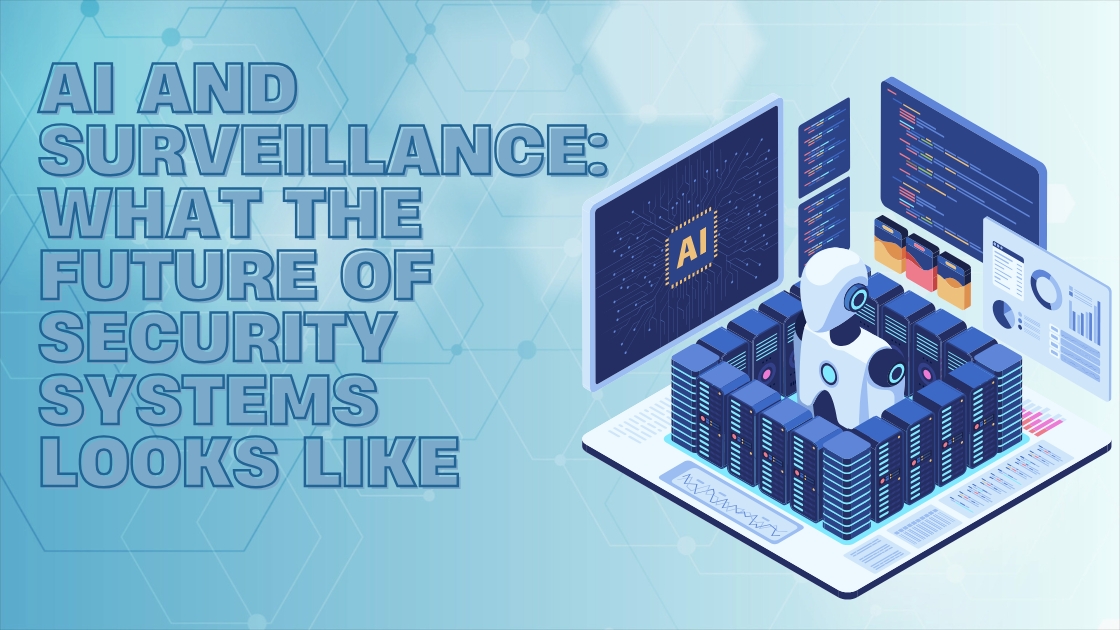Rapid changes are occurring in the realm of security, with artificial intelligence (AI) taking the lead. Things that were previously only imagined in science fiction are now commonplace.
The fast development of intelligent surveillance cameras, predictive analytics, face recognition, and autonomous threat detection is hitting governments, businesses, and families.
But how does this transformation affect the future? Will artificial intelligence make us safer or more prone to threats?

In this blog, we’ll explore the emerging role of AI in surveillance and security, the technologies driving this shift, real-world applications, benefits and risks, and where the future might take us.
Facial Recognition
Face recognition technology, backed by artificial intelligence, is becoming increasingly widespread in security applications. It enables businesses to identify and track individuals on their premises, thereby enhancing access control and security surveillance capabilities.
Artificial intelligence software can match faces to watchlists and inform security staff of matches, and they can respond quickly. In sensitive facilities like airports, banks, and government offices, this technology is beneficial due to its ability to eliminate unauthorized access.
Autonomous Surveillance Drones
The application of artificial intelligence-powered autonomous surveillance drones is transforming security and perimeter monitoring. To supply security professionals with real-time video streams, drones can patrol specific areas, identify intrusions or suspicious behavior, and take surveillance images.
Businesses can obtain larger coverage, quicker reaction times, and increased situational awareness through the automation of surveillance duties, particularly in remote or large-scale regions.
AI-Powered Video Analytics
Using video analytics that is driven by artificial intelligence, standard surveillance cameras have been converted into intelligent monitoring systems.
These systems are capable of conducting real-time, automatic analysis of video feeds, allowing them to detect and alert security experts to potential threats, including intrusions, unusual behavior, or uncommon activities.
By applying artificial intelligence algorithms, surveillance systems can differentiate between normal and abnormal events, thereby reducing false alarms and increasing reaction times.
Integration with Security Operations
AI-powered surveillance systems naturally adapt to overall security operations, offering an end-to-end approach to risk management.
By analyzing AI with access control, alarm systems, and incident response plans, companies can develop an integrated security environment that evolves in response to threats.
This convergence enhances decision-making, resource utilization, and incident resolution, ultimately fortifying security defenses.
Predictive Analytics for Security
Predictive analytics powered by artificial intelligence is a forward-thinking approach to security. AI-powered predictive analytics is forward-thinking security. AI-powered algorithms can predict risks by analyzing past data to develop proactive security methods. This predictive skill allows effective resource allocation.
Machine learning in AI-based surveillance systems identifies threats in massive datasets. AI can identify loitering in a restricted area or suspicious activity and alert security personnel in real time to act.
The proactive approach enhances security and safety. AI cameras notify security personnel of suspicious activity in real time, allowing them to adjust their strategy and allocate resources to mitigate risk, loss, and damage.
Real-Time Alerts and Incident Response
AI-enabled surveillance systems improve incident management and real-time warnings. Security professionals may receive tailored warnings from AI-powered cameras regarding suspicious or unusual behavior. It is essential for remaining awake and reacting quickly to security breaches.
AI-driven systems can accelerate incident response by executing pre-programmed procedures when hazards are identified. It speeds up response times and ensures proper action. These sophisticated technologies provide quick access to video footage for faster problem analysis and resolution.
Due to its ability to discriminate between serious threats and innocuous actions that might disrupt operations, AI can minimize false alerts, a significant benefit.
Smart Object Detection
One other AI advancement in security video is smart object detection. To improve monitoring accuracy and reduce false alarms, AI security cameras can identify a wide range of objects. In settings where you need to differentiate between innocuous and harmful things, this becomes even more crucial.
Objects left unattended and particular dangers may be detected by AI. For instance, AI can notify security if a weapon is identified. Improving security and preventing incidents both need real-time detection.
Smart object recognition enables security personnel to gather valuable information about individuals and items in front of the camera’s lens, as well as identify potential threats. With this understanding of the situation, individuals can make informed choices and allow security personnel to be adequately informed and prepared for any eventuality.
Integration with Current Surveillance Systems
The integration of artificial intelligence with current surveillance technologies is both pragmatic and economical. AI systems can be integrated with existing security infrastructure with minimum disturbance, optimizing current security technology investments. Organizations can improve security without having to replace their entire monitoring system.
Additionally, AI surveillance leverages existing infrastructure, resulting in a more affordable and effective security system. Through the integration of artificial intelligence with existing cameras and systems, organizations can achieve enhanced operational effectiveness and security without incurring significant additional costs.
Final Thoughts
The importance of Artificial Intelligence in surveillance isn’t a distant possibility—it’s already here. From smart cameras in city centers to voice-activated alarms in homes, we’re living in a world where machines help watch over us.
The future holds even more powerful tools. But how we use them—and who controls them—will define the kind of society we live in. As with any powerful technology, we must ask the right questions, set clear limits, and always remember that security should never come at the cost of our humanity.
AUTHOR:
Jennysis Lajom has been a content writer for years. Her passion for digital marketing led her to a career in content writing, graphic design, editing, and social media marketing. She is also one of the resident SEO writers from Softvire, a leading IT distributor.